Recommended Spots
【Equipment Outline】
「This English-language text was created by the Japan Tourism Agency.」
-
【Zuikozan Kiyomizudera Temple (Yasugi Kiyomizudera Temple)】
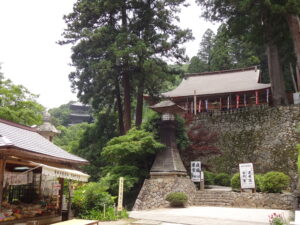
Zuikozan Kiyomizudera is a Buddhist temple in an isolated mountain glen in the eastern part of the city of Yasugi. The temple is reached by a long stone stairway through the forested valley, spanned by weathered gates and flanked at key points by stone lanterns. The temple’s main hall, three-story pagoda, and other structures are built on terraces connected by the long stone stairway. A 1,000-year-old cedar tree dominates the approach to the main hall.
The Legend of Kannon
Zuikozan Kiyomizudera belongs to the Tendai sect of Zen Buddhism; people come here to pray for relief from bad luck. According to legend, the mountain where the temple stands was once an eerie forest where a supernatural shaft of light would appear at night, frightening local villagers. An itinerant priest named Sonryu was asked to discover the source of the light, and while he was searching deep in the forest, an old man appeared before him. The old man said that he had been worshipping Kannon, the Buddhist Goddess of Mercy, for many years, but was ready to move on to the next life, and was searching for someone to continue his practice. Sonryu agreed to take on the task, whereupon the old man presented him with a sacred statue of Kannon, the goddess of mercy. The priest built a simple thatched hut to enshrine the statue, and though the mountain was devoid of water sources, after a week of secret praying, a spring of clear water appeared nearby. This was the origin of Zuikozan Kiyomizudera, which to this day is devoted to Kannon. The name of the temple comes from these two miraculous occurrences: zuiko means “fortunate light,” and kiyomizu means “clear water”.
Imperial Patronage
Historical records seem to indicate that the temple was founded in 587, but the actual date is uncertain. It was fortunate to receive the patronage of Empress Suiko soon after its founding, and later from powerful regional lords. At its peak it had 48 buildings, though now it has fewer than 10. The first large main hall (konpondo) at the temple was built prior to 1393 and was enlarged several times over the centuries. It is built of cedar, and contains a devotional statue of Kannon of unknown date which is usually kept hidden inside an elaborate lacquered cabinet. Statues of the four Shitenno divine guardians that were made during the Heian period (794–1185) stand on either side. When reconstruction was done on the konpondo in 1992, research confirmed that the current building is the fifth and largest to stand in this location.
A three-story pagoda dating from 1859 stands on a high stone terrace a short distance away. It is constructed of hard zelkova (keyaki) wood, which is not often used in this region for pagoda construction. While the local carpenter who built it was not trained in pagoda construction, his skill can be seen in the intricately carved dragons peering out from between the brackets under the eaves. Visitors are allowed to climb to the uppermost story, which is usually not allowed in Japan. A modern treasure house (hozo) displays important artwork and ritual artifacts belonging to the temple, and Zen meditation is practiced at the konpondo. -
【Shojin Ryori】
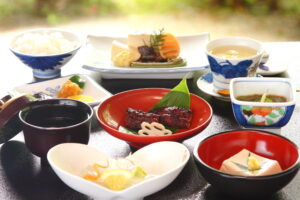
Buddhist precepts prohibit the taking of life, including that of animals, and believers avoid eating meat. An ascetic vegetarian cuisine called shojin ryori that followed these precepts was introduced into Japan from China and India by Buddhist monks in the sixth century, and grew in popularity through the influence of the Zen master Dogen in the thirteenth century. Today, sophisticated and nutritious shojin ryori, free of meat, poultry, fish, and eggs, can be found at temples and restaurants throughout the country. There are three shojin ryori restaurants in the precincts of Zuikozan Kiyomizudera, all open to the general public.
The meals eaten by Zen monks are expected to be simple, often consisting only of rice, pickles, soup, and possibly one side dish. As the cuisine has evolved, typical shojin ryori meals now include soup and three side dishes, plus rice and pickles. The menu is essentially plant- and legume-based. Many dishes are made from soybeans, like tofu in its many variations—such as simple chilled tofu (hiyayakko), fried soybean curd (abura-age), and freeze-dried tofu (koya-dofu). A custard-like tofu made from sesame seeds (goma dofu) is also commonly served. These are accompanied by seasonal vegetables as well as foraged wild mountain plants (sansai) and local wild herbs.
Five Flavors, Five Colors
A principle known as “the rule of five” is generally followed in shojin ryori, meaning that the meal’s ingredients should include at least one each of five colors: green, yellow, red, black, and white—and five flavors: sweet, sour, salty, bitter, and umami. Strong seasonings are avoided, and dashi broth, shoyu soy sauce, mirin (sweet cooking wine), and miso, as well as vinegar and sesame oil, are used in moderate amounts. These should delicately enhance the natural flavors that have been drawn out by combination and preparation. Particularly pungent flavors like onion and garlic are traditionally avoided, but are increasingly used in “progressive” shojin ryori. The key is balance, and a good meal is believed to help the diner achieve a healthy equilibrium of body, mind, and spirit in harmony with the seasons. Care is also taken to avoid wasting ingredients, with vegetable peels and leafy tops being used to make simple broths.
- 【Yasugibushi Performing Arts Center】
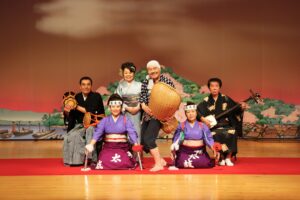
Yasugibushi is a popular style of folk dance that emerged in the Yasugi area during the Meiji era (1868–1912). The dances were initially performed at home, at parties, during festivals, and at other celebrations, but Yasugibushi spread throughout the region, eventually becoming well-known nationwide. To celebrate its popularity, the Yasugibushi Performing Arts Center opened in 2006 in a tile-roofed wooden building, featuring a 200-seat traditional theater. The audience sits on comfortable low seats set on tiers of tatami-mat floors, or on wooden balconies on either side. A hanamichi runway that leads from the stage to the back of the house, like that in a kabuki theater, allows the performers to mingle with the audience. Performances are held four times daily, and the repertoire includes both solo and ensemble dances as well as musical performances. The finale is a slapstick mime called Dojo Sukui (Scooping up loaches), in which a hapless peasant has a hard time trying to catch loaches with a large wicker scoop. The loach motif is used humorously throughout the Performing Arts Center, and loach dishes are even served at the restaurant.
-
【The Site of Gassan Toda Castle】
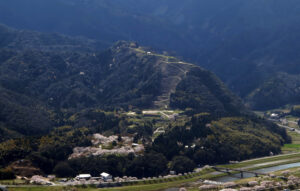
Gassan Toda Castle, a historic fortress, served as a major political and cultural center in Izumo Province, particularly during the Warring States period (1467–1615). It is a prime example of a yamajiro (mountain castle), with the slopes and peak securely configured with separate stone-walled enclosures. A palace was built roughly midway up the mountain, while the most defensible ward was at the top. Although the castle was never destroyed in a conflict, only its stone walls and other relics remain as part of a well-maintained park.
Under Siege
The first structures of Gassan Toda Castle are believed to have been built during the twelfth century. From 1439 to 1566 it was the seat of the powerful Amago warlords, and was regarded as the most impregnable castle in Japan. Under Amago rule the fortress was expanded, and the castle town along the river at the base of the mountain prospered, supporting a population of 10,000 people. Beginning around 1470, Gassan Toda Castle was the target of repeated attacks by rival warlords. Although many direct attacks were successfully repelled, the Amago clan ultimately succumbed after a year-long siege in 1566, opening the castle gates in surrender. The castle was later abandoned when Horio Tadaharu (1599–1633), daimyo of the Matsue domain, relocated his headquarters from Gassan Toda Castle to the newly constructed Matsue Castle in 1611.
The Clever Use of Topography
The layout and design of the castle took advantage of the natural topography of the mountain and its riverfront site for optimal security, with the castle town sited on the narrow strip of land between the Toda River and Mt. Gassan as the first line of defense. Major attacks were expected to be primarily river-borne, so the town housed hundreds of samurai warriors in walled compounds. A wide moat isolated the town from the mountain and castle, and four gates in the walls controlled access to the main enclosures. Unfortunately, a large flood destroyed much of the town in 1666, and almost nothing of the original castle town remains today.
Zones of Defense
The castle was divided into two primary zones. The lowermost zone made use of the broad, relatively gentle lower slopes. The uppermost zone occupied the narrow ridge of the steep 190-meter-high summit. The two zones were separated by a steep slope, and ascent was limited to a single, well-defended path with seven switchbacks.
The zone at the summit had three stone-walled wards in a line along the ridge. The first is believed to have had a three-story defensive tower and a single secure gate, while the third and highest enclosure, the honmaru main ward, was separated from the others by a steep natural ravine. Further along the ridge, at the very summit of the mountain, is the Katsuhitakamori Shrine, the castle’s guardian shrine (though it is believed to predate the castle). The view from these summit enclosures encompasses a broad east-to-west sweep, including Lake Nakaumi and the Sea of Japan to the north and Mt. Daisen to the east.
In the lower zone, many of the relatively flat areas were transformed into isolated walled terraces separated by natural ravines and connected by footpaths. The largest and most significant of these enclosures was located roughly halfway up the mountain. The main palace buildings were located here, well defended by high stone walls with turrets and only approachable through a single secure roofed gate.
A Detailed Model of an Unusual Castle
Following its abandonment in 1611, the castle site largely reverted to nature, with many of its flat terraces used for agriculture over the following years. Hundreds of years later, in 1934, it was designated a National Historic Site, and in 2006 it was selected as one of the 100 best castles in Japan. The growing interest in Gassan Toda Castle led to the establishment, in 2014, of a large-scale restoration and maintenance program that was completed in 2019. The Yasugi City Historical Museum, located at the entrance to the castle site, has a large, detailed model of Gassan Toda Castle and the castle town as well as artifacts, maps, and other historical materials. - 【Wako Museum】
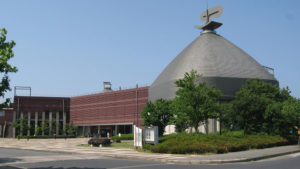
The Wako Museum, established in 1993, is devoted to the history of the traditional Japanese steelmaking technology known as the tatara process. The museum uses informative full-size dioramas, videos, and participatory displays to explain the only method capable of producing the special tamahagane steel that is used to make fine Japanese swords. The Wako Museum was inspired by the influential scientific research of famed Japanese metallurgist Tawara Kuniichi, who held a doctoral degree in engineering and coined the word wako, or “Japan steel,” in 1914.
The city of Yasugi is located at the base of the Chugoku Mountains, which are rich in iron sand, which was the raw material for making traditional high-quality Japanese steel. Combined with the presence of a good port, this allowed Yasugi to become a major steelmaking center. At one time, from the mid-eighteenth through the mid-nineteenth centuries, the city supplied more than 80 percent of the steel used throughout Japan.
A Gravity-Powered Process
The tatara process begins with the iron sand that comes from the natural weathering of granite that contains small particles of iron. In some cases, the iron particles settle naturally into the muddy sediment of rivers and streams. The preferred source for the highest-quality iron sands, however, is an exposed cliff face. A gravity-separation process called kanna-nagashi was developed in the early seventeenth century, in which streams were diverted to form a series of sluices and ponds that separated the heavy iron sand from the rock and mud. This was done only during winter months, when the water was not needed for agriculture.
Tatara steelmaking also required vast quantities of high-quality charcoal, and the Chugoku Mountains were blessed with forests of desirable hardwood trees. One round of steelmaking, called hito-yo, or “one lifetime,” consumes 12 tons of charcoal, the product of 1 hectare of forest trees. During the peak tatara production period in the early nineteenth century, some 60 hectares of mountain forest were destroyed every year. This huge environmental impact was mitigated by restorative forestry practices, but replenishing the natural supply eventually proved difficult.
A New Furnace Every Year
The tatara steelmaking process used a tatara clay furnace aerated with large, human-powered “seesaw” bellows that were connected by fan-like arrays of bamboo air pipes. For each steelmaking operation, a new clay furnace was constructed over a subfloor system of air vents that helped eliminate humidity, which could affect the quality of the steel. The prized tama-hagane formed at the end of the process was one small portion of the 3-ton lump of crude iron which also contained steel of lesser quality. Producing the crude iron took three days of constant fueling with charcoal, aeration, and drawing off of slag, after which the clay furnace was destroyed in order to remove the steel. This process is still conducted several times a year in an almost identical fashion to produce the steel for new swords.
Preserving the Tradition
Until the introduction of the coal-fired blast furnace in the mid-nineteenth century, variations of the tatara method were used throughout Japan to produce iron and steel. The greater economic efficiencies of the blast furnace gradually reduced the viability of the traditional method, and it virtually had disappeared by 1945. Swordsmiths and others who consider tatara steel production a priceless cultural legacy revived the process in recent years. -
【Kano Museum of Art, Yasugi City】
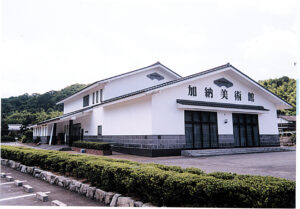
This museum, which stands in a forested valley near the banks of the Iinashi River in the Hirose district of the city of Yasugi, is devoted to the life and work of the painter Kano Kanrai (1904–1977). Kano trained as a Western-style oil painter until 1938, when he was sent with the Japanese Imperial Army to Shaanxi Province in China as a war artist commissioned to produce patriotic paintings. While in China, he took up ink painting and calligraphy, which became his primary focus in later life. Kano’s wartime experience led him to become a peace activist after Japan’s surrender, and in 1949, he began petitioning the Philippine government for amnesty for former members of the Japanese military who had been convicted of war crimes. He sent over 300 remorseful letters to Philippine government leaders, appealing for peace and asking for “forgiveness for the unforgivable.” His patient and persistent efforts finally bore fruit in 1953, when then president Elpideo Quirino declared amnesty for 105 Japanese war criminals. Kano and Quirino, whose wife and three children had been killed in front of him by Japanese soldiers, became close friends and combined their efforts in advocating for peace.
The Layout and Collections
This compact, well-curated museum was founded in 1996 on the site of Kano’s family home by the late Kano Hiroki, the artist’s eldest son. The collection and exhibition spaces are spread over two stories. One gallery chronicles Kano’s peace and amnesty efforts, while others display a rotating selection of more than 120 paintings and other visual works by the artist, beginning with the prewar years and continuing until his death in 1977. The museum also possesses what is considered the best collection of Bizen pottery in Japan, with over 800 items. During special events held at the museum’s tearoom, visitors are allowed to handle selected items from this collection. Over 290 examples of Raku pottery, including pieces by such modern masters as Kawai Kanjiro and Arakawa Toyozo, are included. There is also a sizable collection of Japanese-style paintings (Nihonga) by Ono Chikkyo and Ikeda Yoson, well-known painters who were contemporaries and friends of Kano. -
【Hirose-gasuri Center 】
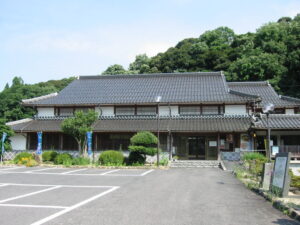
Kasuri is a traditional Japanese textile technique in which threads are dyed to form geometric or pictorial patterns when woven into cloth; the name refers to the distinctive blurred edges of the design patterns. The town of Hirose in Yasugi was the center of a vibrant kasuri industry from 1825 until the early twentieth century, with many unique design features developed over this time. The Hirose-gasuri Center was established in 1985 to promote this valuable local craft tradition. (Kasuri is pronounced gasuri when part of a compound word.)
A Technique Found Throughout Asia
Kasuri is a variation of the ikat technique, which has a long history in Asia. The word “ikat” is Malay/Indonesian, but the technique is believed to have begun in India. Beautiful silk textiles created with this method were brought to Japan via China in the eighth century, and are preserved in the Shosoin Imperial Repository in Nara. The technique became highly developed in the Ryukyu Kingdom (modern-day Okinawa) beginning in the twelfth century, and was brought to southern Japan after the Satsuma clan of Kyushu invaded Ryukyu in 1609. By the mid-eighteenth century, this weaving technique had spread as far as the Nara region in central Japan, and was applied to inexpensive and durable cotton, which made it affordable to many households. Hirose was one of several well-known kasuri production centers in Japan that emerged in the early nineteenth century, and its popular products were shipped throughout the country.
A Detailed and Laborious Process
Weaving high-quality kasuri by hand is extremely labor-intensive, and involves a series of more than 30 steps. It typically requires two to three months to weave a length of cloth sufficient to make a kimono—one tan, which is about 13 meters long and 38 centimeters wide.
The cotton threads commonly used in Hirose-gasuri are laid out on long wooden frames so that they can be marked with the design prior to dyeing. For Hirose-gasuri, reusable paper stencils, some of which have been in use for generations, are employed in this process. The key to kasuri lies in preventing the dye—usually natural indigo—from reaching specific sections of the threads in order to preserve white areas and form the woven pattern. Hirose-gasuri uses the most traditional method of binding the skeins tightly with rough hemp fiber in the desired places so that the dye cannot penetrate. The skeins are then dyed in large vats of indigo and then unbound, washed, and dried, whereupon the thread is ready for weaving. The design and dyeing process is based on careful calculation, and the weaver must maintain accuracy, placing each thread precisely. The binding of the skeins and the weaving of the cloth were traditionally done by individual households, sometimes assisted by children.
Motifs and Patterns
The Hirose-gasuri Center has many fine examples of local kasuri weaving on display, along with a collection of well-preserved antique pattern samples. Whereas kasuri patterns initially tended to be small and geometric, more elaborate pictorial patterns developed later in the nineteenth century. The kasuri craftspeople of Hirose mastered the use of large, bold pictorial motifs that featured auspicious symbols like the crane and turtle, which represent longevity, or other good-luck symbols such as carp or lucky gods. These motifs were then skillfully combined with large geometric patterns, which often appear to be overlaid on each other in dynamic opposition. Simpler geometrical patterns were more likely used for work clothing and kimonos, while bold pictorial patterns were popular for kimonos, floor cushions (zabuton), curtains (noren), and futon covers, all of which have large areas that could display the motifs to good effect.
The focus of the Hirose-gasuri Center is on teaching. Ongoing instructional programs make use of the center’s more than 30 traditional looms. Visitors are invited to participate in short indigo-dyeing workshops, to make purchases from the large variety of Hirose-gasuri textile products on display, and to sample local soba noodles at the center’s soba shop. -
【Sagi-no-yu Onsen】
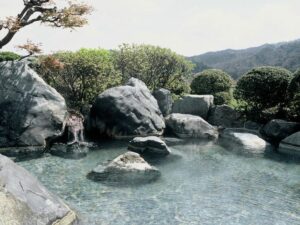
Sagi-no-yu Onsen is a natural hot spring (onsen) located on the Iinashi River in the city of Yasugi. According to legend, the onsen was discovered in the eighth century when an egret (sagi) was observed bathing there to heal an injured leg. During the Warring States period (1467–1615), it was used by successive warlords of nearby Gassan Toda Castle as a palace bath. A terrible flood in 1666 destroyed the hot spring and many settlements along the Iinashi river, and the onsen was forgotten. About 100 years ago, the source of the onsen was rediscovered and made the central feature of a traditional-style ryokan inn. The entrance wing of the inn is a converted 130-year-old farmhouse that once stood near Izumo Taisha. It was carefully dismantled, brought to the present site, and reconstructed. Over the years, several other inns have opened nearby, forming a small hot-spring community that lies within walking distance of the world-famous Adachi Art Museum. -
【Izumo Ori Noki Swan Village】
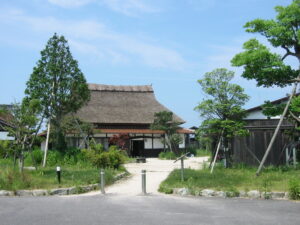
For centuries, a plain in Yasugi has been the autumn home of migrating flocks of swans that come from Siberia to feed on the kernels of grain left in the rice fields after the harvest. A roofed viewing platform allows people to observe and photograph the swans without disturbing them. Nearby is a beautifully restored 100-year-old thatched farm house (kominka) that is typical of the traditional local residences where Izumo Ori woven textiles were made. Until the early twentieth century, weaving was a household industry, and a portion of each farmhouse was commonly devoted to looms and other textile-production materials. The kominka now serves as a community center where dyeing and weaving are taught, and several traditional looms and spinning wheels are set up in a large tatami-floored room. A traditional irori fire pit in the adjoining room provides a place for tea, conversation, and warmth. The center is open to the public.
【Facility Information】
 |
TEL Depends on each facility |
|---|---|
 |
Available |

